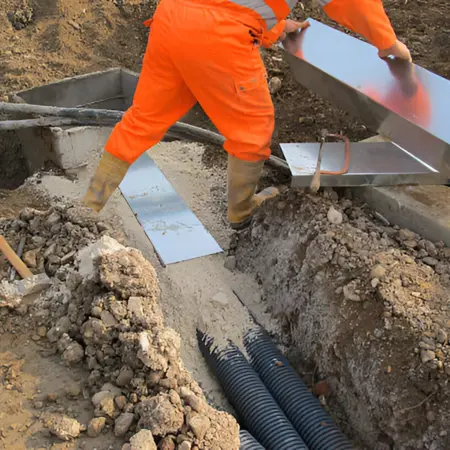Dealing with tree roots in your pipes can be a real headache.
These annoying roots can block water flow and cause big plumbing problems.
This step-by-step guide will show you how to kill roots in pipes and keep your plumbing smooth.
Key Takeaways
- Frequent blockages in your plumbing might mean that roots are causing issues.
- You can cut roots using chemical solutions, like foaming root killers.
- Another option to kill the roots is to use mechanical tools like drills and sewer snakes.
- If roots are causing major issues, hiring a plumber is best.
- Hydro-jetting blasts away roots in your pipes using high-pressure water.
- Selecting tree species with nondisturbing root systems can help avoid future issues.
- Trees and plants near sewer lines provide a perfect environment for roots to grow.
Step-By-Step Guide On How To Kill Roots In Pipes
This step-by-step guide will help you get rid of tree roots in your pipes.
Step 1: Identify The Problem
If you notice that your sinks, toilets, or tubs are draining slowly, it could be a sign of roots blocking your pipes.
Frequent blockages in certain areas of your plumbing can also show that roots are causing trouble.

Diagnostic Tools
You can use plumbing cameras to look inside the pipes to discover what’s happening.
These cameras can help you see if roots are the problem.
If you’re not sure, calling a professional plumber can give you a better assessment of the situation.
Contact us at OP Plumbing Hub for pro services.
Step 2: Choose The Right Root Removal Method
In this step, explore the best ways to remove roots from your pipes.
1. Chemical Solutions
One way to kill roots is by using chemical solutions like foaming root killers.
Products such as copper sulfate can help.
Follow the instructions carefully for safe application, and wear gloves if needed.
2. Mechanical Removal
Another method is using mechanical tools like drills and sewer snakes.
These tools can cut through roots and clear blockages.
While mechanical removal is effective, it may only reach some of the roots and can be messy.
3. Hydro Jetting
Hydro-jetting uses high-pressure water to blast away roots in your pipes.
This method is very effective for heavy blockages but requires a professional to do it right.
4. Professional Help
If the roots are causing serious problems, hiring a plumber is best.
They have the right tools and experience to remove roots safely and effectively.
Contact us at OP Plumbing Hub for excellent services.
Step 3: Treat And Prevent Future Root Growth
Learn how to treat your pipes and stop roots from growing back.

1. Pipe Lining Or Replacement
To keep roots from coming back, consider pipe lining or replacement.
Pipe lining is a trenchless repair method that helps seal pipes.
It also prevents roots from re-entering.
Contact us at Trenchless Sewer Repair Service for expert service.
2. Regular Maintenance
You can regularly use root-killing chemicals to stop roots from regrowing in your pipes.
Routine maintenance is important, too.
3. Landscaping Tips
When planting trees, make sure to keep them away from sewer lines.
Choosing tree species with nondisturbing root systems can also help prevent future problems.
Step 4: Monitor (Track) Your Pipes
Regularly check your pipes for signs of damage and slow drainage.
Scheduling regular plumbing checkups is a good idea.
This way, any issues can be caught early before they become bigger problems.
Keeping an eye on your plumbing can save you time and money in the long run.
How Roots Get Into Pipes
Roots are always searching for moisture and can find it through leaking or cracked pipes.
When water leaks, it attracts roots, making them grow toward the pipes.
1. Signs Of Root Intrusion (Entry)
If roots are getting into your pipes, you might notice some signs.
Slow drains are one of the most common problems, as roots can block water flow.
You might hear gurgling sounds from your pipes.
Frequent backups can happen, indicating that water isn’t draining properly.
2. Common Areas For Root Growth
Roots often access plumbing systems in certain areas.
They commonly grow around the joints where pipes connect or in older pipes with cracks.
Trees and plants near sewer lines are great places for roots to grow.
They can easily reach into the pipes to find water.

When To Call A Professional
Sometimes, your DIY solutions might not be enough.
The root problem can be too big to handle on your own.
If you’ve tried root-killing chemicals, but the roots keep returning, it’s time to call a professional.
Persistent blockages show that you need expert help.
They have special tools and experience that can tackle stubborn roots more effectively.
Contact us at OP Plumbing Hub for excellent services.
How To Choose The Right Plumbing Professional
When looking for a plumber to help with root removal, here are some tips to find the right one:
1. Check Qualifications
Make sure the plumber is licensed and insured.
This means they have the proper training and can protect you from damage during the job.
2. Ask For Recommendations
Talk to friends, family, or neighbors who have had similar work done.
They can give you valuable advice on good plumbers in your area.
3. Read Reviews
Look for reviews online to see what other customers say about their experiences.
A plumber with positive feedback is likely to do a good job.
4. Get Estimates (Rates)
Don’t hesitate to ask for quotes from a few different plumbers.
This will help you compare prices and services to choose the best option.
Conclusion
This article is a guide on how to kill roots in the pipe.
How roots get in to pipes has also been discussed.
Furthermore, it talks about when to call a pro. Contact us at OP Plumbing Hub for expert advice and service.
